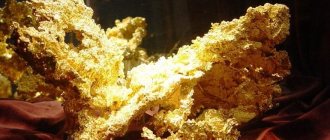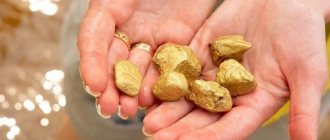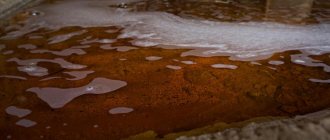Post updated: May 25, 2020
Gold as a precious metal has been used by humanity throughout its history. Its value is determined by the difficulty of extraction: it is difficult to find metal in nature, and even more difficult to extract it from rock. The history of mining the yellow metal has gone through several “gold rushes”, when prospectors in search of gold moved to new territories in North America, Australia and Canada in search of the precious metal and a better life. Similar events were typical for Russia in the 19th and 20th centuries, when the Siberian deposits and Lena gold mines were being developed. How is gold formed and how rare is the metal in nature?
How gold is formed in nature
In our world, gold microparticles are present in everything: animal and plant tissues, minerals, water. But until recently, it was not possible to understand how gold was formed and why it is so unevenly distributed throughout the Earth.
Origin theories
The scientific community officially recognizes two theories:
- cosmogonic;
- theory of conservation of matter.
According to the first version, particles of the yellow metal were brought to Earth by meteorites that bombarded our planet billions of years ago. Another theory states that gold is part of the Earth and was originally contained in its core.
Recent discoveries also support the second version. With the development of engineering, when scientists looked into the most mysterious depths of the sea, studied the composition of the ocean floor near tectonic faults, they managed to get an answer to the most exciting question, where does gold come from.
Here, at the very heart of our planet, the process of formation of elements containing gold was discovered. Under conditions of high pressure, high temperatures and an aggressive acidic environment, one of the most sought-after metals appears.
Solutions saturated with gold rise through cracks in the crust, but closer to the seabed the pressure drops, cold water causes a convection effect, and a chemical reaction begins, resulting in the precipitation of free gold particles or sulfide compounds. By the way, salt water contains quite a lot of dissolved gold, which means that the scientific community has yet to find a way to extract it.
Tools for searching for native gold. Table: the best metal detectors, parameters and prices
To search for gold on your own, you will need a miner's minimum. Tools needed for searching and processing metal:
- metal detector;
- metal washing tray;
- sieve or sifter;
- shovel;
- pick, chisel, hammer;
- magnifying glass, container for found metal.
Metal detectors are sold in specialized stores; they can also be bought inexpensively on Avito. It is recommended to choose equipment with the highest power and sensitivity to metal. Of course, high-quality equipment will not be cheap.
| Metal detector | Characteristics | Price |
| XP Metal Detectors Deus | detection depth – 1 meter, battery charge – up to 10 hours. | 62 thousand rubles |
| White's MX7 | Detection coverage – 1 meter 40 cm, waterproof, battery charging time – 20 hours. | 59 thousand rubles |
| Garrett ATX Deepseeker | Detects metals at a depth of 2 meters, works on all types of surfaces, light weight. | 154 thousand rubles |
Beach metal detector for gold
Properties of gold
Only in films can you see how an exhausted gold miner pulls out a huge piece of gold shining in the sunlight. In reality, it is difficult to detect and recognize this metal in the ground, because it looks completely different. Nuggets, depending on impurities, may not have the usual shine and are characterized by a greenish tint.
You can understand that you have pieces of precious metal in front of you using chemical reagents and physical experiments. Gold differs in several ways:
- low electrical resistance;
- high thermal conductivity;
- easy to forge and polish;
- has high reflectivity.
But the main quality lies in the inertness of the noble metal. Gold does not react chemically with other elements except fluorine, cyanide and oxygen, but this requires high temperatures and certain conditions. It dissolves only in a mixture of nitric and hydrochloric acids, called aqua regia.
What to do if you find a gold nugget
Native gold is the property of the state. For legal production, a license is issued. Next, the raw materials with precious metal are supplied to refineries.
If a nugget is found by chance, and this often happens at deposits, it must be handed over to the local tax authority. The finder will receive a 20% reward from the value of native gold (Article 229 of the Civil Code of the Russian Federation). Income and pension taxes will be withheld from the amount, and the remaining money will be transferred to a bank card.
Watch vlogs of how amateurs search for precious stones:
When did gold become valuable?
Archaeological excavations have shown that people used the precious metal as early as the 5th century BC. But early human settlements used raw gold.
People began to create gold household items and jewelry much later.
The earliest gold jewelry, dating back to the Bronze Age, was found in Ireland. True, metal was not very popular among these people. It was exchanged at the market for goods more valuable to the northerners.
Active ore mining in the Ancient world was carried out in the Mediterranean countries. Residents of the Middle East supplied ore and products made from it to Egypt. The most ancient jewelry made of precious metal was discovered in the tombs of the Egyptian queen and ruler of the Sumerians. Both specimens date back to the 3rd millennium BC.
In Russia, the first gold mine was discovered only in 1732 by prospectors from the Arkhangelsk province. But they began to develop it much later. The official start date of work is considered to be 1745. In total, the first Ural deposit yielded 65 kg.
bunny ears
In the Urals, near the small settlement of Leninsk, one of the largest gold mines in Russia, discovered under Alexander I, operated for many years. At the beginning of 1935, when the gold mine was preparing to close, a lonely prospector Pyotr Simonov accidentally discovered a piece of gold in the ground, the weight of which exceeded 3.3 kilograms. But the nugget was considered unique not because of its mass, but because of its shape. It resembled a hare's head with long ears.
According to the laws of that time, such a large piece of gold could not remain the property of Simonov and he had to give it to the state. The nugget was placed in the royal treasury, from where it later ended up in the National Museum of Mineral Resources of Russia. The replica of “Hare Ears” is kept in the local history museum of the Chelyabinsk region.
In what form can gold be found in nature?
A natural deposit can contain ore in two forms: grains or nuggets. Both species have fundamental differences, and the principle of their formation still remains a mystery to scientists.
grains
The most common variety. Gold fractions up to 15 g in size are called grains. As a rule, grains contain a minimum of impurities, so their extraction is considered the most economically efficient.
The method of their extraction is to sift the rock. The remaining grains of the precious metal gave rise to a gold rush that arose on three continents at once: North America, European Russia and Australia.
Nuggets
Pieces larger than 15 g are called nuggets. The formation of nuggets occurs much less frequently, but their value is much higher. The larger the size of the piece, the more valuable the find will be.
In some sources you can find mention of a 2.5-ton nugget, which was extracted from the ground in the 11th century. The nugget has not survived to this day, and finding something similar is now almost impossible. The specimens found in recent history are much smaller, but some still deserve attention:
- The Australian continent is remembered as the location of the record holder among nuggets. The giant is known as the “Holtermann Plate”. The weight of the find was 100 kg.
- The second place is occupied by a giant dug up on the island of Hokkaido. The name of the nugget is “Japanese”, weight – 71 kilograms.
- The Ural nugget weighing 36 kg got its name “Big Triangle” due to its unusual shape.
- The Magadan “Golden Giant” closes the circle of famous nuggets. True, its weight is quite modest, only 14 kg.
Nuggets are never pure gold. And impurities can change the color of the metal beyond recognition. Therefore, it is very difficult to detect a nugget, and only an experienced specialist can determine whether it belongs to a noble metal.
What is the difference between gold nuggets and gold nuggets?
From the point of view of the average person, both types of ore can be called gold. But for a gold miner the difference is quite noticeable:
- The grains contain up to 97% pure gold; nuggets are replete with impurities that are difficult to remove.
- Mining grains is more economically profitable.
- Nuggets are extremely rare.
Gold miners make money mainly from grains. Finding a good nugget is considered a great success and promises not so much income as prestige, creating a name for the miner.
Small, but smart
If we analyze the results of prospecting and exploration work for many deposits in the Verkhoyansk-Chukotka region, it turns out that for the majority of nugget placers, primary sources (quartz veins) were never found. In a number of placers, based on the degree of alluvial processing of nuggets (i.e. processing under the influence of constant water flows), it can be assumed that their displacement from primary sources is only a few hundred meters.
This is evidenced by both the weak roundness of the nuggets and the high (50% or more) quartz content. Nests of iron hydroxides are also often observed, among which sometimes there are remains of incompletely oxidized sulfides.
These features indicate a shallow section of bedrock sources. If we proceed from the above-mentioned hypothesis of N.V. Petrovskaya, then we can assume that only the “heads” of ore bodies were cut off, and in the immediate vicinity of the place where the nuggets were found there should be deposits in which the main reserves of the metal are concentrated.
However, as the history of gold mining testifies, prospectors often found such nuggets, but the most thorough searches for ore bodies were fruitless. Therefore, it can be assumed that the primary sources of nuggets are small gold veins, which in some cases can be completely destroyed.
In support of these conclusions, examples can be given where primary sources of placers with nuggets were discovered. And in all cases they were thin (up to twenty centimeters thick) veins with a nested distribution of metal. Since the inter-cluster areas, as a rule, are weakly gold-bearing, such veins are not of industrial importance. For large gold deposits with thick ore bodies (about 1 m or more), nuggets, alas, are not typical.
Interesting results were obtained when studying the morphological features of nuggets. When comparing the linear dimensions of nuggets with their weight, it was found that their length and width are, on average, proportional to their weight. However, this rule does not apply to the thickness of nuggets (Samusikov, 2005).
An analysis of the literature data regarding the fineness of nuggets, their sizes and their origin from thin veins shows that these are not regional features of the deposits of the Yana-Kolyma belt, but general patterns of nugget regions around the world.
Types of deposits
There are only two types of gold deposits in nature: primary and secondary. The former are also called indigenous, the latter – alluvial.
Conventionally, one can also distinguish this type of deposit as alloys. Here the ore contains not only gold, but also silver, copper, nickel or platinum. The actual gold content in such deposits will be reduced, but they are often discovered during the development of other materials.
Indigenous
Primary deposits of gold are found in rock, in places of ancient volcanic activity. The metal in such deposits originates as a result of the solidification of lava that comes to the surface. The reaction with cold air gives rise to quartz and freed grains of gold in the lava.
The primary deposits are rich in gold dust, which can only be found using special equipment. The extent to which the rock will be saturated with grains of noble metal depends on the predominance of certain elements in the chemical composition and the intensity of quartz formation. There are deposits from 100 to several thousand tons.
Alluvial
This type of deposit is the most convenient for development. The ore lies as close to the surface as possible. The placer can be concentrated along river beds or hidden in the voids between layers. A secondary deposit is obtained under the influence of physicochemical factors:
- washing out of primary deposits by groundwater;
- temperature changes;
- influence of microorganisms and so on.
The occurrence of gold in secondary mining areas will vary in quantity and quality. Unlike primary ones, they are smaller, from 5 to 50 tons. In addition, such quarries are subject to repeated washouts. Often new deposits are discovered after tectonic movements, landslides or soil subsidence.
Normandy Nugget
Another name for the nugget is “Solid Normandy”. It was found in 1995 by miners working at a mine near the town of Calgourie (Australia). According to the data recorded in their diaries, the mass of a single piece of gold was 25.5 kilograms. After being melted down, it lost about 20% of its weight. The nugget was sold to the management of Newmont Gold Corporation. The gold bar, obtained after melting down a block of precious metal, is in the private collection of the Perth Mint.
How are deposits developed?
Gold mining is a long and labor-intensive process. Today, like hundreds of years ago, gold is sought through numerous trials and errors. This requires not only professional knowledge of geology and the ability to conduct terrain reconnaissance. Observation, experience and even an intuitive approach help in the search.
In this case, it is necessary not only to find a deposit, but also to conduct chemical analyzes, take samples, run test drilling... All this allows us to draw a conclusion about the percentage of gold content in the rock and the profitability of quarry development.
Preparatory measures include the following:
- visual exploration of the area;
- determining the boundaries of a gold deposit;
- preparatory work in engineering;
- rock testing for gold content;
- calculation of economic profitability;
- establishing ownership of the deposit lands;
- construction of a production station equipped with specialized equipment.
Careful study of the terrain is a very important component. After all, the gold mining industry is one of the most expensive. The enterprise employs thousands of employees, and the construction of the station and the purchase of equipment costs more than one billion dollars. Mistakes in choosing a location are simply unacceptable.
Pepita Kanaa
A piece of gold weighing 60.5 kilograms was found in Brazil in 1983 by a miner with many years of experience, Julio Filo. When extracting a nugget from the depths of the Serada-Palada mine, it was accidentally split into two unequal parts. The ore was bought by a coin minting company. A huge coin was smelted from it, which was called Pepita Kanaa. The weight of the product was 52 kilograms. 8.5 kg of impurities were sifted out during the process of melting down a piece of gold. The coin was transferred to the monetary museum of the State Bank of Brazil, where it remains to this day as the main exhibit. Anyone can look at this masterpiece of the mint.
Geography of places attractive to prospectors. Gold-bearing rivers of Russia
You don't have to go to the Klondike to feel the spirit of the gold rush. Russia is extremely rich in placer gold.
Around the first half of the 19th century, the term “Siberian gold” appeared. The Irkutsk region and Krasnoyarsk region turned out to be rich in many gold deposits. They were discovered inside the basins of the Ob, Tom, and Yenisei rivers. Now the Siberian precious metal is the basis of the gold mining industry of the Russian Federation.
In Bashkiria, gold was discovered in the valleys of 7 rivers in the Uchalinsky region. Nuggets weighing about 16 kilograms were found here. At the moment, gold mining in these territories is not developing so actively, although it has excellent prospects.
Oliver Martin, 36 kg
One of the largest gold nuggets was found in the USA, in the state of California. It was named after the person who found it - Oliver Martin . This happened in 1854. Oliver at that time was slightly richer than the average tramp.
He and his friend drank heavily and walked out of the bar, heading to the camp. But an incredibly heavy downpour began, and the partners found themselves in the rain at the foot of the mountain. The rain caused flooding in the area.
The water that poured from the cliff washed the friends straight into the stream. Martin almost drowned, but was able to grab onto the branches of a tree and hung like that until the morning. Then the water finally went away.
But his friend, John Fowler, could not survive the flood. Oliver decided to dig a grave for him near the rock. Having dug a hole, he suddenly came across a huge nugget, it was the size of a bull’s head.
The lucky owner of a huge piece of gold became rich, the nugget was sold for $22,700, and was later demonstrated in different cities of the United States. Martin himself became rich.











